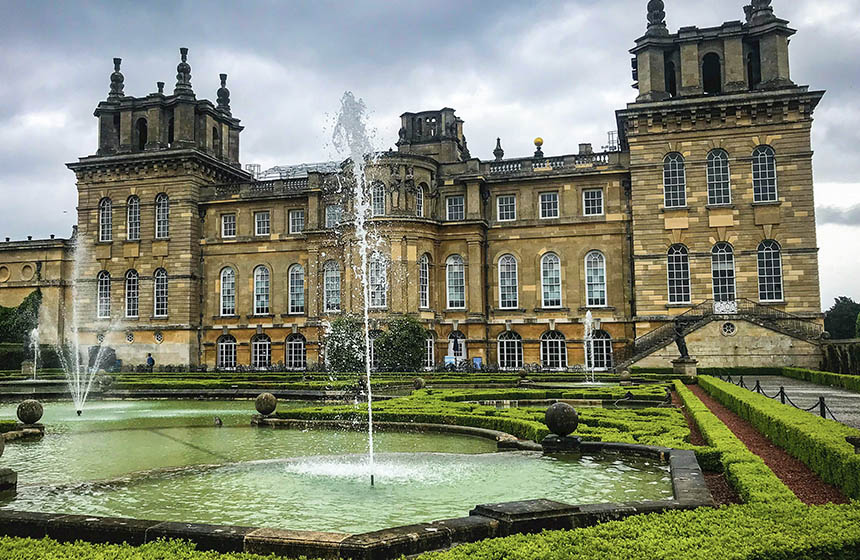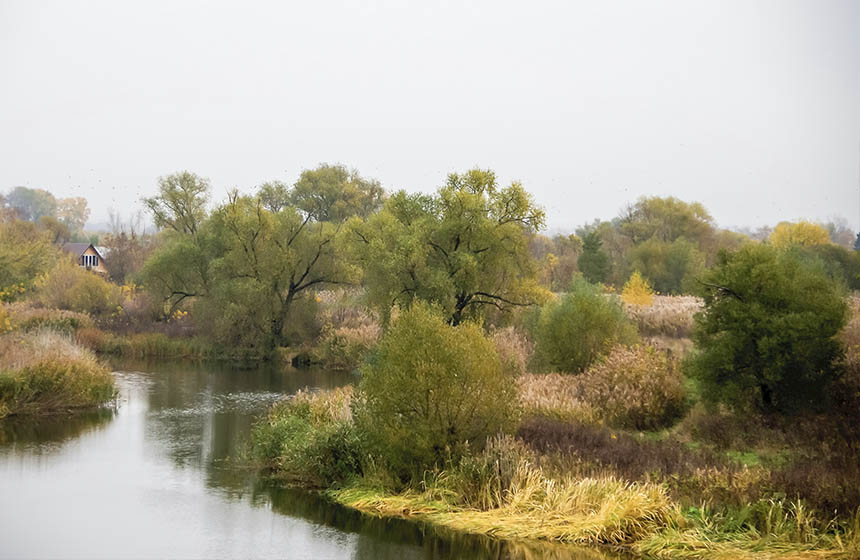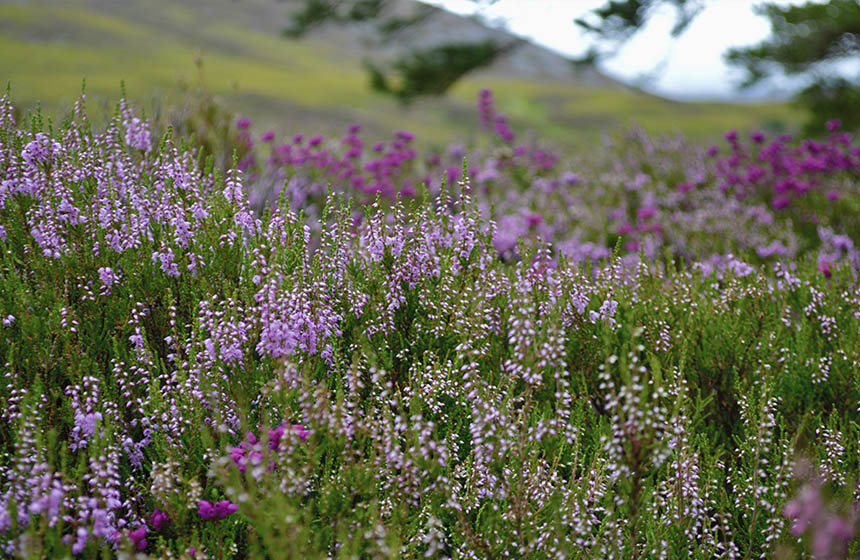The Blenheim Estate: Nature-based solutions in a historic parkland
The Blenheim Estate shows how nature-based solutions can be used within and around a historic parkland and World Heritage site, to support Net Zero goals, improve water quality, provide health and wellbeing benefits and support local economies.
Nature-based intervention:
A range of nature-based approaches are being used at Blenheim in support of their Net Zero ambitions, as well as to reduce soil erosion, improve water quality and support local communities. Native woodlands (along with commercial timber species) have been planted on the sides of the Dorn and Glyme valleys, north of the historic parkland, to sequester carbon and reduce runoff of sediment into the river. On the valley floor, the floodplain is being restored by creating wetlands and re-meandering the channel. These measures are intended to reduce the sediment load entering Blenheim Lake, which had to be dredged recently at great expense as it had become extremely shallow.
Within the historic parkland, the ancient wood-pasture at High Park is managed through grazing by cattle to trample the bracken (1). The estate has also recently partnered with the Berkshire, Buckinghamshire and Oxfordshire Wildlife Trust (BBOWT) to develop plans for restoration of the northern part of the park, including new wildflower meadows for pollinators, potentially funded through biodiversity net gain (2). These initiatives are carried out in partnership with conservation organisations, research groups, and local businesses. In addition, Blenheim Estate aims to create local jobs and support local businesses, (3), as well as creating active travel routes, encouraging health walks and hosting forest schools.
Overview of context:
Blenheim Park is a UNESCO World Heritage Site and a major visitor attraction. The Palace and gardens are set in a Capability Brown parkland that includes the highest concentration of ancient oak trees in Europe. High Park, an ancient oak woodland designated as a Site of Specific Scientific Interest (SSSI), has been under continuous management since mediaeval times, originally as a deer park with fishponds and timber production (1), with new oaks planted for 25 years starting in 1983 (4). The northern part of the parkland is used for agriculture, and has now been reverted from arable to pasture. As well as the park, the estate (which covers 12,000 acres) includes farmland and forestry in the surrounding area, and is involved in housing development on its land. Blenheim Estate aims to show how its ambitious sustainability targets can be delivered as part of a viable business model that also balances the need to maintain the historic landscape and cater for large numbers of visitors.
Case effectiveness on
Climate change
Blenheim aims to be a carbon neutral estate by 2027. Carbon emissions for Blenheim Palace have fallen from the 2019-20 baseline of 32,673 tonnes of CO2 equivalent (tCO2e), from energy, visitor travel, procurement, food and drinks, retail, waste, and water, to 13,796 tCO2e in 2022-23. This was supported by 5,177 tCO2e sequestered through natural capital on the estate and 624 tCO2e offset through the Green Journey Funnel.
To achieve this, the estate reduced its energy use as well as planting trees for carbon capture and restoring wetlands. In 2022, they partnered with Morgan Sindall Group, a construction group, to plant over 250,000 trees including hornbeam, lime, sycamore, wild cherry, oak, Norway maple, alder, and beech trees, with an understory of woody shrub species (5) (6). It is estimated that the trees will sequester 22,000 tonnes of CO2 over 25 years.
To reduce flood severity, the estate is partnering with the Environmental Agency, Thames Water, and the Evenlode Catchment Partnership to restore wetland habitats by blocking man-made drains and adding fallen wood to mimic beaver dams (7). This project is expected to prevent downstream flooding as well as reducing the sediment load entering the Blenheim Lake, downstream.
Ecosystem health
Ecological effect: PositiveHigh Park, the ancient woodland site in the estate, is protected from visitors. Surveys since 2016 in High Park have found 2,800 different species, including 19 mammal, 275 plant, 334 fungi, 243 beetle, 600 moth, 20 butterfly, 35 arachnid, 161 ant, wasp and bee species (8). Nest boxes have been installed around the estate, and 45 owlets have fledged from these since 2006 (9).
Eleven bat species are found on the estate, including the nationally rare barbastelle bat and the range-restricted lesser horseshoe bat (10). BSG Ecology conducts bat surveys and assesses how to minimise impacts on bats from building conservation works, collaborating with the Oxfordshire Bat Group to install and monitor bat roosting boxes (11).
Non-native honeybee colonies that may spread disease or pose competition to native colonies are removed using a ‘trap hive’ method (12). 27 new log hives were also created, which were found to house 11 new bee colonies as of 2023. In addition, Blenheim Palace partners with Rowse Honey, a UK honey company, to improve habitats and conserve native bee species as part of the Rowse Hives for Lives programme (13). This partnership has resulted in the planting of wildflowers and hedgerows across 50 acres of previously intensively farmed estate land. The parkland and Formal Gardens are left partly uncut to encourage wildflowers, and where lawns are cut the height of the blades are increased so that clovers remain. Biodiversity surveys in 2022 reported increases in butterfly species and kestrel sightings around planted areas (14).
Blenheim is also part of the North-east Cotswolds Farmer Cluster’s Landscape Recovery programme (see separate case study), an ambitious project aiming connect habitats across the region with a focus on floodplain restoration and species conservation (15). This is at the planning stage, and outcomes are not yet reported.
Socioeconomic outcomes
The estate creates opportunities for employment, with 560 direct employees and a total of 3,435 jobs supported in 2022 to 2023 (16). The Palace gift shop sources locally produced items, creating opportunities for startups to sell their products.
The Grass Routes project aims to increase connect the surrounding local communities through the creation of cycle routes and walking paths on the estate (17). Interactive trails, such as the Rowse Bee Discovery Trail, also raise awareness of initiatives on the site (13). The estate partners with the University of Oxford to design and implement projects that link patients in primary care and people facing homelessness, poverty, and disadvantage with programmes that can improve their wellbeing (18). The Aspire project, which organised walks and mindfulness activities in the estate, was reported to result in a 20% increase in life satisfaction, a 19% reduction in anxiety, and a 12% increase in step count for participants (19).
Governance
Local participation in Governance: NoThe Blenheim Palace Heritage Foundation is a registered charity established to conduct landscape and visitor management (20). The Board of Trustees governs the charity, and appoints a senior management team that supports these Trustees (21).
Finance
Restoration projects, including the £9 million project to restore the Queen Pool and repair the Grand Bridge, are funded through visitor spending, public and corporate donations, and fundraising activities (22). The estate is also part of the North East Cotswold Farmer Cluster that is funded through £500,000 of government funding to create and restore 3,271 hectares of interconnected habitats along Evenlode Valley. The tree-planting initiatives were funded through sale of voluntary carbon credits to Morgan Sindell Group, and were verified using the Woodland Carbon Code.
Monitoring and evaluation
Monitoring of biodiversity at the estate includes wildlife surveys at High Park that count the number of species and individuals, the monitoring of bat colonies under bridges using thermal imaging cameras and bat echolocation detectors (23), and the monitoring of bird chicks in the nest boxes (9). In addition, Blenheim Estate partners with Oxford Robotics Institute and Oxford Biology to develop technology to monitor the estates’ ecosystems and structures (24). For example, projects include the use of robots to collect information on species diversity using imaging sensors, and the creation of tools to monitor and map climatic and environmental changes that may impact architecture on the site.
Trade-offs and limitations
The new woodland planted on the estate is a mix of native species, designed to form permanent woodland, and non-native species designed to be felled as part of commercial forestry rotations. The inclusion of commercial forestry provides an income and supports jobs, but these species have little biodiversity value. Also, much of the carbon stored by the trees is likely to be released shortly after they are harvested, as currently only 84% of timber felled in the UK is used for long-lived products such as furniture or construction; the rest being used for fuel, paper, pallets or fencing (25).
While the dredging of silt in the Queen Pool was deemed necessary to improve its ecological condition, the dredging process could pose disturbances to wildlife. To combat this, BSG Ecology conducted wildlife surveys and implemented measures to avoid disturbance (26).
References
- Blenheim Estate. N.d. High Park. https://www.blenheimestate.com/land/strategy/natural-balance/high-park/
- Berkshire, Buckinghamshire, & Oxfordshire Wildlife Trust. 2022. BBOWT partners with Blenheim to put nature at heart of estate. https://www.bbowt.org.uk/news/bbowt-partners-blenheim-put-nature-heart-estate
- Blenheim Palace. N.d. Charity and community. https://www.blenheimpalace.com/community/
- Baggs, A. P., Blair, E. C., Colvin, C., Cooper, J., Day, C. J., Selwyn, N. and Townley, S. C. 1990. Blenheim: Park from 1705. Pp 460-470 in A History of the County of Oxford: Volume 12, Wootton Hundred (South) Including Woodstock. Editors Crossley, A and Elrington, C. R. British History Online, London. https://www.british-history.ac.uk/vch/oxon/vol12/pp460-470
- Blenheim Estate. N.d. Morgan Sindall creating nine new public access woods on our estate as part of ‘unprecedented’ tree planting project. https://www.blenheimestate.com/news/morgan-sindall-tree-project.html
- Blenheim Estate. N.d. Growing Natural Capital. https://www.blenheimestate.com/land/strategy/landed-gently/growing-natural-capital/
- Blenheim Estate. N.d. Stage zero. https://www.blenheimestate.com/land/strategy/landed-gently/stage-zero/
- Blenheim Estate. N.d. Survey reveals biodiversity of our ancient woodland. https://www.blenheimestate.com/news/survey-biodiversity-woodland.html
- Blenheim Estate. N.d. Barn owl chicks hatch out in our nest boxes. https://www.blenheimestate.com/news/owl-chicks-hatch.html\
- BSG Ecology. 2022. Promotion of the profession: Blenheim bats on the countryfile. https://bsg-ecology.com/promotion-of-the-profession-blenheim-bats-on-countryfile/
- Blenheim Estate. N.d. Bat’s amazing – our estate is a rich location for rare colonies. https://www.blenheimestate.com/news/rare-bat-colonies.html
- Blenheim Estate. N.d. Bees on the Blenheim Estate. https://www.blenheimestate.com/land/strategy/natural-balance/bees/
- Rowse Honey. N.d. Discover the enchanting world of Britain’s wild bees at Blenheim Palace. https://rowsehoney.co.uk/news/bee-educated/discover-the-enchanting-world-of-britains-wild-bees-at-blenheim-palace
- Rowse Honey. N.d. Rowse and Blenheim Palace Estate see wildlife thriving as part of major conservation project. https://rowsehoney.co.uk/hives-for-lives/feed-the-bees/wildlife-thriving-as-part-of-major-conservation-project
- Blenheim Estate. N.d. Local farmers join forces with our estate. https://www.blenheimestate.com/news/local-farmers-join-forces.html
- Blenheim Palace. 2023. Blenheim local newsletter winter edition. https://www.blenheimpalace.com/flipbook/blenheim/2023/Blenheim-Local-Newsletter-Winter-2023/
- Blenheim Estate. N.d. Grass routes. https://www.blenheimestate.com/land/strategy/grass-routes/
- Blenheim Estate. N.d. Natural Health Service. https://www.blenheimestate.com/land/strategy/natural-health-service/
- Blenheim Estate. N.d. Social prescribing with Aspire. https://www.blenheimestate.com/land/strategy/natural-health-service/aspire/
- Blenheim Palace. 2022. Appointment of a Trustee. https://starfishsearch.com/wp-content/uploads/2022/03/Blenheim-Palace-Appointment-of-a-Trustee.pdf
- Blenheim Palace. N.d. Senior Management Team. https://www.blenheimpalace.com/about-us/smt/
- Blenheim Palace. N.d. Saving ‘The Finest View in England’. https://www.blenheimpalace.com/restoration/savingthefinestview/
- Blenheim Estate. N.d. Abseiling ecologists monitor our Grand bridge’s rare bats. https://www.blenheimestate.com/news/rare-bats.html
- Blenheim Estate. N.d. We are trialling robot dogs to monitor our estate’s ecosystem. https://www.blenheimestate.com/news/robot-to-monitor-estate%E2%80%99s-ecosystem.html
- Forest Research (2021) UK Forestry Statistics 2021. https://www.forestresearch.gov.uk/tools-and-resources/statistics/forestry-statistics/forestry-statistics-2021/. Table 2.5 indicates that 40% of UK produced softwood is used for short-lived panels, fencing, pulp or fuel and 60% is sent to sawmills, of which Table 2.17a indicates that 27% is used for construction (16% of the total) and the rest for short lived products (fencing, pallets and packaging). Table 2.6 indicates that 91% of UK produced hardwood is used for fuel.
- BSG Ecology. N.d. Blenheim Palace: Ecological lake restoration. https://bsg-ecology.com/portfolio_page/blenheim-palace-ecological-lake-restoration/

Intervention type
- Management
- Protection
- Restoration
Conducted at landscape scale
Ecosystem type
- Temperate forests
- Wetlands
Climate change impacts addressed
- Freshwater flooding
Instigators
- Local private sector
Societal challenges
- Biodiversity conservation
- Climate change mitigation
- Economic and Social development
- Health
- Energy security
Outcomes
- Food security: Not reported
- Water security: Not reported
- Health: Positive
- Local economics: Positive
- Livelihoods/goods/basic needs: Not reported
- Energy security: Positive
- Disaster risk reduction: Not reported
- Rights/empowerment/equality: Not reported
- Recreation: Positive
- Education: Not reported
- Conflict and security: Not reported
- No. developmental outcomes reported: 6
Resources
Read resource 1Literature info
- Grey literature




